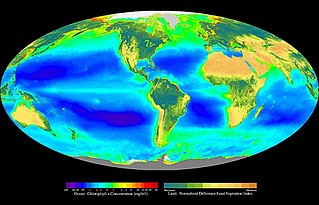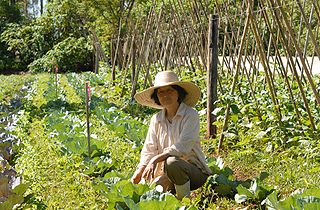Related Research Articles

The biosphere, also known as the ecosphere, is the worldwide sum of all ecosystems. It can also be termed the zone of life on Earth. The biosphere is virtually a closed system with regard to matter, with minimal inputs and outputs. Regarding energy, it is an open system, with photosynthesis capturing solar energy at a rate of around 100 terawatts. By the most general biophysiological definition, the biosphere is the global ecological system integrating all living beings and their relationships, including their interaction with the elements of the lithosphere, cryosphere, hydrosphere, and atmosphere. The biosphere is postulated to have evolved, beginning with a process of biopoiesis or biogenesis, at least some 3.5 billion years ago.

Biosphere 2 is an American Earth system science research facility located in Oracle, Arizona. Its mission is to serve as a center for research, outreach, teaching, and lifelong learning about Earth, its living systems, and its place in the universe. It is a 3.14-acre (1.27-hectare) structure originally built to be an artificial, materially closed ecological system, or vivarium. It remains the largest closed ecological system ever created.
Industrial ecology (IE) is the study of material and energy flows through industrial systems. The global industrial economy can be modelled as a network of industrial processes that extract resources from the Earth and transform those resources into products and services which can be bought and sold to meet the needs of humanity. Industrial ecology seeks to quantify the material flows and document the industrial processes that make modern society function. Industrial ecologists are often concerned with the impacts that industrial activities have on the environment, with use of the planet's supply of natural resources, and with problems of waste disposal. Industrial ecology is a young but growing multidisciplinary field of research which combines aspects of engineering, economics, sociology, toxicology and the natural sciences.

A life-support system is the combination of equipment that allows survival in an environment or situation that would not support that life in its absence. It is generally applied to systems supporting human life in situations where the outside environment is hostile, such as outer space or underwater, or medical situations where the health of the person is compromised to the extent that the risk of death would be high without the function of the equipment.

Closed ecological systems (CES) are ecosystems that do not rely on matter exchange with any part outside the system.
BIOS-3 is an experimental closed ecosystem at the Institute of Biophysics in Krasnoyarsk, Russia.
Controlledecological life-support systems are a self-supporting life support system for space stations and colonies typically through controlled closed ecological systems, such as the BioHome, BIOS-3, Biosphere 2, Mars Desert Research Station, and Yuegong-1.
Soil functions are general capabilities of soils that are important for various agricultural, environmental, nature protection, landscape architecture and urban applications. Soil can perform many functions and these include functions related to the natural ecosystems, agricultural productivity, environmental quality, source of raw material, and as base for buildings. Six key soil functions are:
- Food and other biomass production
- Environmental Interaction
- Biological habitat and gene pool
- Source of raw materials
- Physical and cultural heritage
- Platform for man-made structures

Secondary treatment is the removal of biodegradable organic matter from sewage or similar kinds of wastewater. The aim is to achieve a certain degree of effluent quality in a sewage treatment plant suitable for the intended disposal or reuse option. A "primary treatment" step often precedes secondary treatment, whereby physical phase separation is used to remove settleable solids. During secondary treatment, biological processes are used to remove dissolved and suspended organic matter measured as biochemical oxygen demand (BOD). These processes are performed by microorganisms in a managed aerobic or anaerobic process depending on the treatment technology. Bacteria and protozoa consume biodegradable soluble organic contaminants while reproducing to form cells of biological solids. Secondary treatment is widely used in sewage treatment and is also applicable to many agricultural and industrial wastewaters.

Bioastronautics is a specialty area of biological and astronautical research which encompasses numerous aspects of biological, behavioral, and medical concern governing humans and other living organisms in a space flight environment; and includes design of payloads, space habitats, and life-support systems. In short, it spans the study and support of life in space.

A primarylife support system (PLSS), is a device connected to an astronaut or cosmonaut's spacesuit, which allows extra-vehicular activity with maximum freedom, independent of a spacecraft's life support system. A PLSS is generally worn like a backpack. The functions performed by the PLSS include:

The Micro-Ecological Life Support System Alternative (MELiSSA) is a European Space Agency (ESA) initiative with the aim to develop the technology for a future regenerative life support system for long-term human space missions. Initiated in 1989, the design is inspired by a terrestrial ecosystem. As of 2023, MELiSSA is a consortium made up of 30 organisations across Europe.
This is a glossary of environmental science.

The natural environment, commonly referred to simply as the environment, includes all living and non-living things occurring naturally on Earth.
A spome is any hypothetical system closed with respect to matter and open with respect to energy capable of sustaining human life indefinitely. The term was coined in 1966 by Isaac Asimov in a paper entitled "There’s No Place Like Spome", published in Atmosphere in Space Cabins and Closed Environments and originally presented as a paper to the American Chemical Society on September 13, 1965. Asimov himself declared his coined word to be uneuphonious, and defined it as being a portmanteau of the two words "space home".

A nutrient cycle is the movement and exchange of inorganic and organic matter back into the production of matter. Energy flow is a unidirectional and noncyclic pathway, whereas the movement of mineral nutrients is cyclic. Mineral cycles include the carbon cycle, sulfur cycle, nitrogen cycle, water cycle, phosphorus cycle, oxygen cycle, among others that continually recycle along with other mineral nutrients into productive ecological nutrition.

Space farming refers to the cultivation of crops for food and other materials in space or on off-Earth celestial objects – equivalent to agriculture on Moon.
Lunar Palace 1, Moon Palace 1 or Yuegong-1 is a Chinese research facility for developing a moon base. It is an environmentally closed facility where occupants can simulate a long-duration self-contained mission with no outside inputs other than power/energy.
The Algatron was a proposed and prototyped waste filtration and recycling system to be implemented on NASA missions. Designed and built by a pair of sanitary engineers at the University of California, Berkeley, William J. Oswald and Clarence Golueke, the Algatron relied on algae to provide carbon Dioxide absorption and oxygen generation as well as "microbiological waste conversion" for "humans sealed within an isolated capsule.". A working model was built by Oswald and Golueke in 1965 or 1966 under a contract by from the Air Force Cambridge Research Laboratories. Composed of two stacked cylinders lined with Algae, the cylinders would spin in opposite directions. With ports to allow sunlight in, nutrients were introduced via some overflow mechanism. Despite the promise that the Algatron represented, and the ways in which Oswald and Golueke "understood that the closed environment of the space capsule was itself just the a microcosm of the closed system of the earth's biosphere," the technology would never get past the prototype stage. NASA instead decided to go with fecal bags to deal with waste. The Russians developed a similar system, the BIOS-3, which got as far enough as a successful test run with human occupants in 1965.

Eu:CROPIS was a life science satellite developed by the German Aerospace Center (DLR) and intended to investigate the possibility of growing plants in different levels of gravity, such as that of the Moon and Mars, as a sustainable food source using human urine for moisture and as the source of fixed nitrogen.
References
- ↑ Liu, Hong; et al. (2012). Bioregenerative Life Support Systems in Space: A Research Update. New Developments in Science and Technology - 60th Anniversary Special Issue, Beihang University (BUAA). A Sponsored Supplement To Science. pp. 86–87.
- ↑ Mitchell, CA (1994). "Bioregenerative life-support systems". Am J Clin Nutr. 60 (5): 820S–824S. doi: 10.1093/ajcn/60.5.820S . PMID 7942592.
- ↑ Sheehy, Cody. ""Earthlight" Documentary".